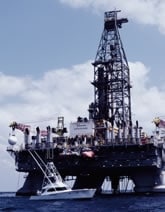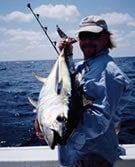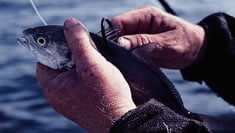
The combination of rigs, rips and the proximity of the continental shelf adds up to one thing in the mind of Captain Peace Marvel: yellowfin tuna, and lots of them! “The yellowfin is one of the strongest fish in the ocean,” Marvel tells me as we motor out of South Pass on the Mississippi River delta. “I love to catch them, and there are lots of them to be caught out here. It’s a year-round sport that offers anglers the chance to battle fish that can weigh over 200 pounds.” That’s no hyperbole, as Marvel’s personal best is a 206-pounder he caught last year.
The great thing about pursuing yellowfins out of Venice, Louisiana, where Marvel’s charter operation is based, is that it’s a fairly quick-hit option. In May and June, the best places to find yellowfins are along the rips and around the oil and gas rigs that lie 20 to 50 miles off South Pass, near the edge of the continental shelf, where the water depth ranges from 200 to 6,500 feet. The best rigs sit in 4,000 to 6,500 feet of water, while the best rips can be located anywhere from a few miles out of South Pass to well past the 50-mile mark.
Baitfish such as pogies and hardtails (blue runners) are the big reason the tuna are here. “No bait, no tuna,” says Marvel, who has been fishing this area for the better part of 30 years. “At least that’s the way it works most of the time. When I’m fishing the rips, I’m looking for strong current lines with a definite color change. And most of the time I prefer to fish a rip without grass (sargassum weed). Of course, grass will attract baitfish. That’s for sure. But a clean rip with lots of current will also pull in bait, and that attracts an assortment of game fish.

Trolling around the offshore rigs – whether it involves slow-trolling live baits or picking up the pace with artificials – is a productive way to uncover action with hard-fighting tuna in the Gulf of Mexico.|
“I’ve found big fish on rip lines in 210 feet of water. But you never know where the best rips are going to be on any given day. And you never know which rips will be holding the bait and tuna. It’s a trial-and-error situation.
“The rips are where I catch my heaviest tuna, along with marlin, wahoo and dorado (dolphin). You won’t normally catch large numbers of tuna around the rips, like you will around the rigs, but they will almost always be huge fish. I’m talking about 150-pound-plus tuna.”
Rip It Up
Marvel has two tactics for fishing the rips. One is slow-trolling live baits, while the other is trolling a spread of Ilanders at six to eight knots. “About the only lures I troll are blue-and-white Ilanders,” says Marvel. “They are the best, bar none. I use both bullet heads and bubble heads. The bubble heads have a concave face and leave a good bubble trail. The bullet heads swim and skip. Both drive big yellowfins crazy.”
Marvel’s trolling spread usually includes four lines rigged with Ilanders and a fifth rigged with a dolphin-colored Braid Marauder, which swims in the prop wash. His trolling outfits consist of Cape Fear 5080 stand-up rods matched to Shimano 50-wide LRS Tiagra reels. His Ilanders are rigged with a Mustad 7691, 7/0 needlepoint southern tuna hook. The wind-on leaders are ten feet of 300-pound fluorocarbon.
As mentioned, Marvel will also fish live baits along the rips. In this case, he’ll troll on one engine. “I like to fish the rips with ten- to 14-inch hardtails,” he says. “In that situation, I’ll be moving around a lot, covering water. Therefore, I hook the baits through the lips, which keeps them from turning and flipping. Plus they’ll live longer. I like to pull them as fast as I can get away with.”
An 8/0 Mustad 39550 Demon circle hook is used with the larger hardtails, and the ten-foot leaders are either 130- to 300-pound fluorocarbon. Live baits are fished on the same outfits as the lures.
“Since I tend to catch bigger yellowfins along the rips, I prefer to fish the biggest hardtails I can find,” says Marvel. “The advantage of using a big bait is that you’ll catch bigger fish, sometimes big marlin.”
Working the Rigs

When the rips aren’t producing, Marvel heads for the deep-water rigs. Some are fixed structures, while others are “floaters.” His favorite rigs are the Lena, Cognac, Moxie, Mars, Ursa, Medusa and Elf. Another is the Deep Water Horizon, a floating rig. It was a hot rig last summer, but its location can change. By the time you read this, it could be drilling somewhere off the coast of Africa!
“I usually fish live baits at the rigs,” says Marvel. “Finding baitfish around the rigs is important, as it’s a sign that game fish are probably in the area. Ideally, I’ll catch my baits around the rigs. That way they are fresh and more than likely the type and size that the tuna are feeding on. But getting out there with baits in the live well is good insurance, too. My favorite live bait is a hardtail, the bigger the better. A ten- to 14-inch hardtail is perfect.”
Making Bait
Marvel uses Mustad Pescador SPR-6 Sabiki rigs to catch his hardtails. He casts the Sabiki close to the rig, lets it sink, and retrieves it with sharp jerks of the rod tip. Counting the seconds as the rig sinks gives him a good idea of what depth to fish it when he hooks up.
Since several baits are usually hooked on the same Sabiki at once, it’s best to have one person at the helm, one person fishing and another handling and unhooking the fish as they come aboard. Getting them off the hook and into the live well quickly is very important.
Marvel also uses a castnet to catch pogies (menhaden) in the surf before heading out to the rigs. The pogies measure five to seven inches long and make good baits, although they aren’t nearly as good as hardtails.
Troll, Chum and Cast
| ### Rigging & Trolling Hardtails |

Louisiana charter captain Peace Marvel knows that yellowfin tuna love hardtails, so he takes advantage of that predator-prey relationship to score around the rigs and rips.|
When rigging a seven- to ten-inch blue runner, Peace Marvel uses a 6/0 live-bait hook, as he feels that a smaller hook keeps the bait alive longer. He places the hook in front of the bait’s dorsal fin to make it swim downward. Most of the time, Marvel bump-trolls his live baits by occasionally taking the engine in and out of gear. Larger hardtails are often rigged with an 8/0 circle hook placed in the bait’s back (above).
“By hooking them in the back, I have better control over the depth at which they are fished,” says Marvel. “Plus, I get more hook-ups. One thing you don’t want to do is pull the baits too fast. That’ll make them spin and flip on the surface.”
With live baits he’ll use a ten-foot, 300-pound-test fluorocarbon leader.
– Robert Sloan
Lures can also be used to catch yellowfins around the rigs. Marvel’s top lures for rig trolling include the blue-and-white Ilander, the 113MR MirrOlure in hot pink, the Mann’s Magnum Stretch 30 in blue/chrome, and the dolphin-colored Braid Marauder. Rods, reels and leaders are the same as those used on the rips.
One of the most exciting ways to catch yellowfins around the rigs is on a popper, which is why Marvel keeps a spinning rod rigged with a five-inch Terminator Popper on hand for when the tuna surface. The big spinning reel holds 375 yards of 80-pound Spectra and a ten-foot wind-on leader made of 80-pound fluorocarbon. When you hook a tuna on this rig, be prepared for a long fight.
Chumming can help draw tuna to the surface at the rigs. It’s especially effective on suspended yellowfins that show up on the fishfinder. Marvel likes to chum with rainbow runners, hardtails, squid and other baits that can be caught at the rigs on Sabikis and chopped into small pieces. However, be sure not to overdo the chumming. Tossing out a few chunks every few minutes is enough to keep the fish interested without overfeeding them.
May and June are prime months to fish the rips and rigs off Louisiana, and action continues through the rest of the summer. As an added bonus, you stand a very good chance of hooking up with blue marlin, wahoo and dorado, not to mention some outrageously big sharks, specifically makos. Marvel says that makos up to 770 pounds have been caught in these waters.
If this sounds like your kind of adventure, give Marvel a call at (985) 534-2278, or go to www.reelpeace.com. For details on Cypress Cove Lodge and Marina in Venice, call (888) 534-8777, or go to www.rodnreel.com/cypresscove.

Rig-Trolling Spread |









